
Since March is recognized as National Nutrition month, I’m sharing my “Cruise for Clues with The 20-25 Dietary Guidelines” which is a collection of ready to teach lessons and movement activities like a scavenger hunt followed by a case study and culminating project to help you present the dietary guidelines to your students in a variety of interactive ways as well as help them apply what they’ve learned. Read on to learn more…
Set
- Give students 3-5 minutes on a timer, a white board and markers and ask them to complete a “brain dump” of everything they know about the dietary guidelines.
- When time is up, have students share what they wrote. You will probably find that most students don’t know very much about them.
Materials
- iPads or Laptops
- Projector & Screen
- Printed Clue Posters
- Printed Action Cards
Activities
- Introduce and/or review the 20-25 Dietary Guidelines with the “Did You Know” slide presentation. Students will get a copy of this via Google Classroom so there is no need for them to take notes.
- After reviewing the above document, students will participate in a “Cruise for Clues” scavenger hunt type activity. Students may access the “Did You Know” resource at any time throughout the activity. If you are teaching in person, print the posters and randomly hang/lay around the room. The beauty of this is that it does not matter which station students begin. Students simply read the clue prompt on the visual they start at and then proceed to investigate other visuals to find the answer (letter).
- As students cruise for clues, they will record their answers on the provided chart. Be sure to remind them that the answer will NEVER be on the same poster as the clue prompt. This is set up to grade easily, as at a quick glance you can see if it is correct because of the short phrase the ordered letters will spell out!
- Afterwards, as students to think critically as they answer this prompt: If you could add an additional guideline to the list that would improve health, what would it be? Why? I do this as an ASK on Google Classroom. Discuss as a class or grade individually.
- Next, I present students with a dietary guidelines case study. For the first part of the case study, students watch a short video titled, “Rewind the Future” and answer corresponding questions.
- We discuss the video and questions as a class before moving on to the second part of the case study.
- The second part of the dietary guidelines case study can be done individually or as a small group. Randomly pass out the “Food & Lifestyle Choice Cards” to students.
- I asked students to Imagine they were Jim…, the cards received are the actions and choices Jim made or did after his heart attack and release from the hospital.
- Students read and sort each card into an imaginary T-Chart as Positive/Healthy or Negative/Unhealthy on their table and then complete the prompts on the assignment.
- Students screenshot the T-Chart of sorted cards and “mark it up” with positive/negative headings before attaching it to the Google Classroom assignment.
- When students finish, we discuss the results of their food and lifestyle cards. Students really responded well to this activity and good discussion resulted.
- I ended this portion by asking students why I included both positive and negative food and lifestyle cards. The concluding message was as follows: “When your health depends on you changing your diet and lifestyle, the best you can do is take it one day at a time, making gradual changes. You will have good days and bad days! On those days you “fall off the wagon”, it’s important to get back on and try again. Eventually, the changes will become habits and you will see results to your health.”
- Culminate the lesson by having students create a project that helps Jim make better food choices. There are two versions of this project depending on your time and skill level of your students. The first option is more detailed and requires more time and effort from the students and the second is a shorter, easier and less detailed version.
- Optional: If you wanted to offer a lab that reflects many of the dietary guidelines, you could could offer the healthy snack lab. This lab is ethnic…representing a variety of cultures, low in added sugar, saturated fat and sodium, affordable because made from scratch and doable in 43 minute class periods. The snacks include: Hummus with carrots or whole wheat pretzels, Guacamole with tortilla chips, and Salsa with tortilla chips.
Attachments
- Did You Know…Dietary Guidelines Presentation (PDF)
- Cruise for Clues Visuals (PDF)
- Cruise for Clues Answer Sheet (PDF)
- Dietary Guidelines Case Study (PDF)
- Dietary Guidelines Choice/Action Cards (PDF)
- Help Jim Follow the Dietary Guidelines Option #1 (PDF)
- Dietary Guidelines Scavenger Hunt Option #2 (Please make a copy by going to file, click make a copy in or to edit.)
- Healthy Snack Lab Recipes (please make a copy)

